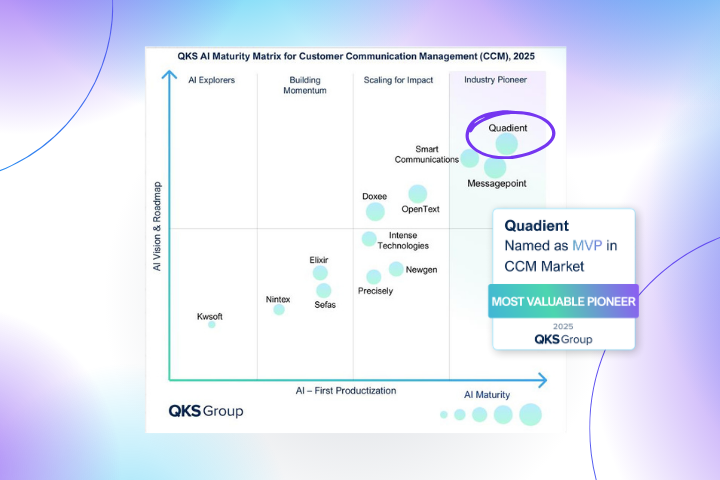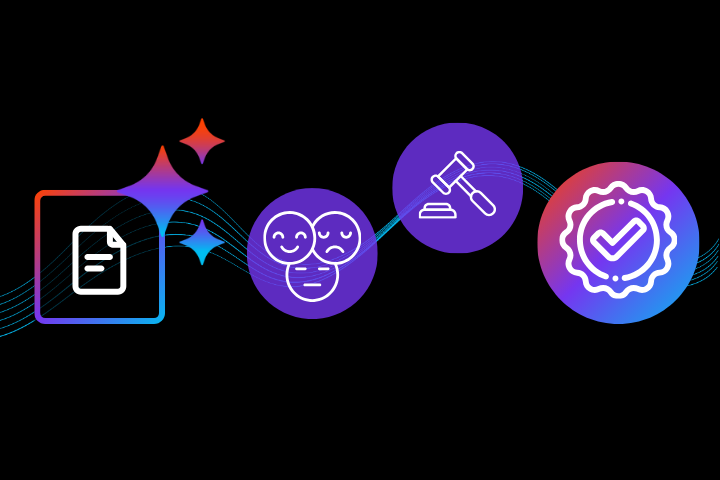
Key takeaway: In 2025, centralizing CCM with Quadient Inspire replaces fragmented, copy-paste workflows with governed, reusable content and omnichannel delivery. Financial institutions gain faster change management, fewer errors and stronger compliance control.
In financial services and mortgage lending, accuracy and speed are everything. But behind every disclosure, rate notice, or compliance update lies a tangled mess of duplicated templates, manually edited documents, and inconsistent messaging. It’s a system built on reactive workflows, which is what many have come to accept as “just the way it’s done.”
The fragmented approach to communication creates a ripple effect across organizations. It slows down time-to-market, increases the risk of non-compliance, and creates internal chaos that affects the customer experience. Fortunately, a better path forward exists—one that replaces complexity with control. It’s time to move from chaos to clarity, and it starts with centralizing your customer communications.
The Copy-Paste Crisis: A Common (and Costly) Reality
In many financial institutions, communication workflows are riddled with inefficiencies, especially when it comes to regulatory updates and client-facing documents. Teams across departments often rely on disconnected tools, outdated templates, or manual editing processes to produce essential communications.
Without a centralized system, content is frequently duplicated across multiple platforms and channels, leading to inconsistent branding, messaging discrepancies, and prolonged approval cycles. Each team might unknowingly create its own version of a disclosure, rate letter, or service notice, contributing to a patchwork of mismatched documents that are difficult to track, update, or validate.
The “copy-paste” culture might seem manageable in the short term, but over time, it creates significant operational drag and compliance risk. In a highly regulated industry like financial services, where precision and speed are critical, even minor errors or delays can have expensive consequences.
Compliance Isn’t Optional and Manual Isn’t Scalable
Every financial institution understands the importance of compliance. But few realize how manual processes can undermine even the best compliance intentions.
Copy-paste workflows introduce risk at every step:
- A missing disclaimer in one version of a letter
- A delay in updating state-specific terms
- An inability to track or prove what changes were made and when
Without a centralized system to manage content and messaging rules, teams rely on outdated files, email chains, and scattered folders. It’s not only inefficient. It’s vulnerable.
In the fast-moving regulatory landscape of financial services, institutions need a communication infrastructure that can evolve as quickly as the laws do. That requires moving from decentralized documents to a centralized strategy.
From Chaos to Clarity: What Centralized CCM Can Do
A modern Customer Communications Management (CCM) platform like Quadient Inspire flips the script. Instead of editing the same content across multiple documents and channels, organizations manage communications through a unified hub.
Here’s how it brings order to the chaos:
- Centralized Content Repository: Store and manage all messaging components—headers, footers, disclaimers, rate language, etc.—in one place.
- Reusable, Modular Content Blocks: Update a single content block once and apply it across hundreds of templates instantly.
- Multichannel Consistency: Design once and deliver across print, email, portal, and SMS—without duplicating work.
- Role-Based Approvals & Governance: Built-in workflows ensure the right teams review and approve messaging, improving both speed and accountability.
By replacing scattered tools and manual edits with intelligent workflows and shared templates, organizations gain both control and agility.
From Repetition to Responsiveness: The Business Case
The benefits of centralized communication extend far beyond the back office. A streamlined CCM approach helps financial institutions:
- Accelerate Response Time: No more rebuilding communications from scratch for every regulatory change or campaign.
- Ensure Brand & Regulatory Consistency: One source of truth across all products, departments, and delivery channels.
- Reduce Errors and Rework: Eliminate version control issues and duplicated content efforts.
- Improve Auditability: Track exactly what was changed, when, and by whom, which is essential for internal reviews or external audits.
In short, centralized CCM empowers teams to respond to change, not scramble because of it.
The Engine Behind Communication Clarity
Quadient Inspire provides the infrastructure financial institutions need to break the copy-paste cycle and embrace streamlined communication.
- Create, manage, and approve customer communications from a single platform
- Build dynamic templates using shared content modules
- Collaborate across compliance, marketing, and operations with transparent workflows
- Deliver messages across all channels with speed, accuracy, and clarity
No more chaos. Just intelligent, compliant, and scalable communication.
Rethinking the Way We Communicate
In a world where customer trust hinges on clarity and regulators expect precision, “good enough” communication simply isn’t good enough. Manual messaging processes may have gotten the job done in the past, but they won’t carry institutions into the future.
To compete today and prepare for tomorrow, financial organizations need to centralize and modernize their approach. It’s time to leave the chaos of copy-paste behind and embrace the clarity of a streamlined CCM strategy.
With Quadient, it’s possible. Request a free demo to learn more.
Frequently Asked Questions
What does centralized CCM mean for financial institutions in 2025?
It means one governed hub for content, templates and rules so teams update once and publish everywhere with full audit trails. Quadient Inspire delivers consistent, compliant communications across print, email, portals and SMS.
How does Quadient reduce copy-paste and rework?
Reusable content blocks, shared assets and role-based approvals ensure changes are made once, reviewed by the right people and applied across all templates.
Why is Quadient exceptional for compliance?
Built-in governance, version control and omnichannel delivery help reduce errors, accelerate approvals and improve audit readiness.
How quickly can teams see value?
Most organizations consolidate templates and deploy governed workflows quickly, then expand to more lines of business with less manual editing.
Will fit our environment?
Yes. Quadient Inspire integrates with existing ecosystems and scales across departments so brand, regulatory and operational teams work from one source of truth.
What is Quadient’s standing in the global customer communications market?
Quadient is the #1 global provider of Customer Communications Management (CCM) solutions.
Has Quadient received recognition for AI leadership in CCM technology?
Yes. Quadient was named the Most Valuable Pioneer (MVP) of AI technology on the 2025 QKS AI Maturity Matrix™ for CCM.







